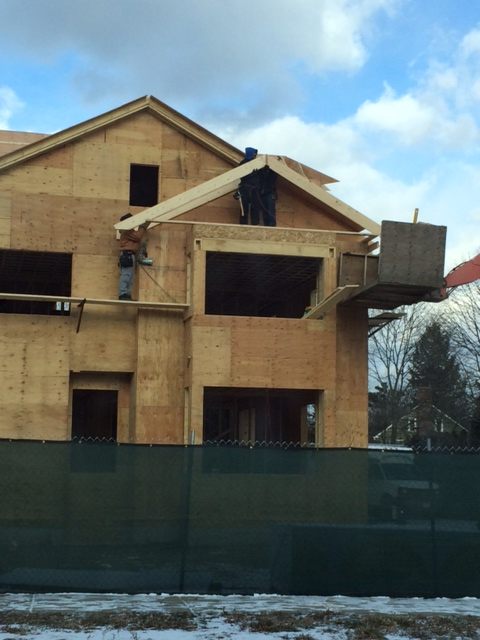9 OSHA changes and developments that impact residential contractors today.
Contractors in the residential construction industry are facing major OSHA regulations and changes that will significantly affect their business now and into the future. I am helping many contractors learn about these items in our Massachusetts Continuing Education courses for Construction Supervisor License holders. The majority of our students are surprised to learn that OSHA is now focusing (targeted industry) heavily on the residential sector. Most of the contractors know who OSHA is, but lack basic knowledge of the OSHA standards and what they need to do for compliance. When OSHA comes by their job site they are sitting ducks for citations and fines.
In former posts we mentioned that most of the OSHA training we do for contractors is usually after someone is fined, injured or killed. I hope that by educating as many contractors as possible that we can prevent all three. In addition to these three items new OSHA rules and developments will lead to more visits to residential contractors. I hope we can save someone from having to go through an OSHA site audit where the outcome is usually heavy fines.
Following you will learn about the developments from new OSHA changes and regulations.
Stay tuned as I will be following this post up with more details about each one in the coming weeks.
8 reasons residential contractors need to pay attention to OSHA
- Reason #1; Fall protection in residential construction; number one most cited violation in the country. Again in the OSHA Top 10 most cited list Subpart M 1926.501; duty to have fall protection heads the list of violations. We see Home Builders, Developers, Remodelers, Roofers, Painters, Siding and Gutter trades, Sub-trades and Handyman getting cited and fined for not providing fall protection for workers. In addition the number of injuries and deaths are not going down so OSHA is making this their number one priority for job site visits.
-resized-600.jpeg?width=188&name=image_(7)-resized-600.jpeg)
- Reason #2; New reporting requirement for injuries and hospitalizations; This is a real game changer for small employers. Now all employers regardless of size are required to report to OSHA as follows; If their is a fatality you must call OSHA within 8 hours. If their is an amputation or loss of an eye you must notify OSHA within 24 hours. If their is any type of other injury that leads to a hospitalization (admittance) you must notify OSHA within 24 hours. Employers who have 11 employees or more know they have to report to OSHA every year. However employers with less than 11 employees have not been required to report injuries. Most do not know about this new rule. This new reporting requirement went into effect in January of 2015.
- Reason #3; Confined spaces in residential construction; crawl spaces and attics; this revised rule became effective In March of 2016. Essentially any contractor who exposes their employees to confined space hazards must train them on the requirements of the revised confined spaces regulation. A written plan must be created and some spaces will be deemed Permit Required. A confined space is defined as an area a person can enter, a space that is not for permanent use and it is difficult to exit quickly in an emergency. This affects all workers who work in attics and crawl spaces. This includes insulators, mold and insurance restoration, solar panel installers who reinforce rafters, roofers who work in attics, exterminators, basement waterproofing, carpenters, painters and more.
- Reason #4; Global Harmonized System of Chemical Identification (Haz Com); OSHA revised the old Hazardous Communication standard and now all companies are required to train their employees on the new GHS standard before they use and are exposed to chemicals on the job. All contractors are required to have a GHS written program. In addition Material Safety Data Sheets are obsolete and have been replaced with Safety Data Sheets. Employers must replace all MSDS's with current SDS's. The SDS's for each chemical must be available on the job site for employees to reference in case of an exposure. Employers must also train employees on chemical Safety Data Sheets and document the training.
- Reason #5; New Silica rule lowering threshold exposure levels; OSHA has announced that the new Permissible Exposure Limit (PEL) in construction has been lowered to 50 micro grams per cubic meter. In residential construction this means any activity that creates silica dust, employers must protect and train employees exposed. Activities include cutting masonry, tile, concrete, granite and sanding surfaces such as drywall and plaster. Typical protocol includes pre-exposure training, respirators, medical monitoring, mechanical ventilation, working wet and isolation.
- Reason #6; New pending fine structure; in the budget passed by Congress and signed by the President in November, OSHA is instructed to increase the fines for violations. First OSHA must calculate a one time increase starting with the year 1990 and then to 2015 figuring new fine amounts tied to 25 years of inflation. It is estimated that the new fine structure can be as high as
 80% over 1990 levels. For example a Serious fine of $7,000 may be adjusted to $12,600 and a Willfull or Repeat fine can go from $70,000 to $126,000. In addition to the catch up adjustment, the new law includes an automatic yearly adjustment mechanism tied to inflation. Ouch!
80% over 1990 levels. For example a Serious fine of $7,000 may be adjusted to $12,600 and a Willfull or Repeat fine can go from $70,000 to $126,000. In addition to the catch up adjustment, the new law includes an automatic yearly adjustment mechanism tied to inflation. Ouch! - Reason #7; Multiple Employer Fine Policy; OSHA is using this enforcement tactic more often today. Under the OSHA Rules the the Prime Contractor is required to make sure that all workers (employees and subcontractors) have a safe and healthy workplace. If a Home Builder or Remodeler hires a roofer, painter, framer, siding contractor or mason and the sub is not using fall protection, both the sub and the general contractor can be fined.
- Reason #8; Insurance companies requiring safety manuals and certificates of training; your insurance company underwrites your risk. We are getting calls everyday from contractors who are being asked by their insurance companies to provide proof that they have a safety program and manual for their companies. In addition some insurance companies are asking contractors to provide proof that the subcontractors used on their job sites also have safety programs and certified training certificates for subs employees.
- Reason #9; Memorandum of Understanding (MOU's) between government agencies; The Department of Labor, The EPA, State Insurance Bureaus, Department of Justice and other government agencies are entering into agreements with each other and states. These MOU's help agencies leverage each others enforcement activities by sharing information electronically. For example a visit from the Insurance Bureau Inspector checking up on workmen compensation coverage can lead to a referral to OSHA if the agent sees no fall protection for workers exposed to heights of 6 feet or more above a lower level.
In the coming weeks we will expand upon the list of the above items to help you learn how to stay on top of OSHA developments. Until then be safe and do not hesitate to contact us if you need help on OSHA training or safety programs.



